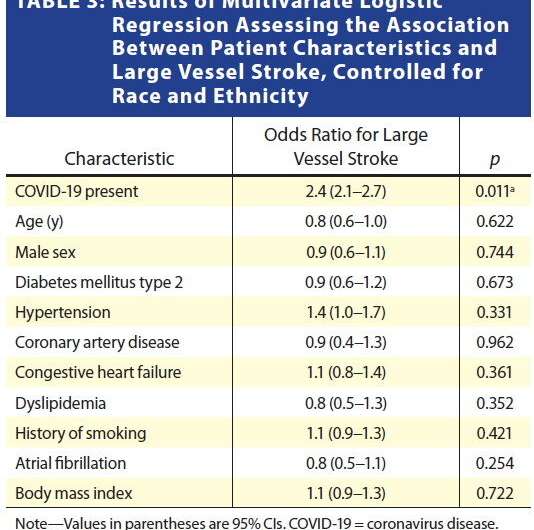Note--Values in parentheses are 95% CIs. aStatistically significant at p < 0.05. Credit: American Roentgen Ray Society (ARRS), American Journal of Roentgenology (AJR)
An open-access article published in ARRS' American Journal of Roentgenology (AJR) investigating the association between coronavirus disease (COVID-19) and stroke subtypes determined that patients with COVID-19 presenting with acute neurologic symptoms warrant a lower threshold for suspicion of large vessel occlusion (LVO) stroke, thus necessitating prompt workup.
"To our knowledge, this is the first study to describe an association between COVID-19 and large vessel strokes," wrote lead investigator Shingo Kihira of the Icahn School of Medicine at Mount Sinai.
This retrospective case-control study included patients for whom a code for stroke was activated during March 16 to April 30, 2020 at a single system of six hospitals across the New York City boroughs of Manhattan, Queens, and Brooklyn. Demographic data (age, sex, and race or ethnicity), COVID-19 status, stroke-related risk factors, as well as clinical and imaging findings pertaining to stroke were collected from the electronic medical record.
Among the 329 patients (175 [53.2%] men, 154 [46.8%] women; mean age, 66.9 years) in the study sample, 35.3% (116) had acute ischemic stroke confirmed with imaging; 21.6% (71) had LVO stroke; and 14.6% (48) had small vessel occlusion (SVO) stroke.
The most commonly observed LVO [62.0% (44/71)] was middle cerebral artery segment M1-M2 occlusion. Meanwhile, multifocal LVOs were observed in only 9.9% (7/71) of patients with LVO stroke.
In the latest AJR Podcast episode, Benjamin Kipper at UC Davis Medical Center in Sacramento further examines the association between COVID-19 and stroke subtypes, as well as the effects this association can have on clinicians and radiologists. Credit: American Journal of Roentgenology (AJR)
With COVID-19 present in 38.3% (126/329) of patients, the 61.7% (203/329) of patients without COVID-19 formed the negative control group. LVO stroke was present in 31.7% of patients with COVID-19, compared with 15.3% of patients without COVID-19 (p = 0.001). SVO stroke was present in 15.9% of patients with COVID-19 and 13.8% of patients without COVID-19 (p = 0.632).
As Kihira et al. explained: "In multivariate analysis controlled for race and ethnicity, presence of COVID-19 had a significant independent association with LVO stroke (odds ratio, 2.4) compared with absence of COVID-19 (p = 0.011)."
After stratification for race and ethnicity, the results from this AJR study indicate that the risk of large vessel stroke among patients with COVID-19 was 2.4 times as high as that among patients without COVID-19.
"Although the incidence of SARS-CoV-2 infection in New York City is declining, a large population of patients continue to present with COVID-19," Kihira and colleagues noted. Clarifying that COVID-19 is associated with LVO stroke—but not with SVO stroke—the authors of this AJR article reiterated the lower threshold of suspicion for large vessel stroke in COVID-19 patients who present with acute neurologic symptoms.
More information: Shingo Kihira et al, Association of Coronavirus Disease (COVID-19) With Large Vessel Occlusion Strokes: A Case-Control Study, American Journal of Roentgenology (2020). DOI: 10.2214/AJR.20.23847
Journal information: American Journal of Roentgenology
Provided by American Roentgen Ray Society























